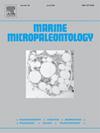加拿大不列颠哥伦比亚省Nanaimo群圣东统-坎帕尼亚统(上白垩统)中Areoligeraceae、Ceratiaceae、Gonyaulacaceae和Peridiniaceae的鞭毛藻囊新种
IF 1.5
4区 地球科学
Q2 PALEONTOLOGY
引用次数: 0
摘要
本文首次研究了不列颠哥伦比亚省东温哥华岛和登曼岛纳奈莫群地层中晚圣东—晚坎帕尼亚早期鞭毛藻包囊组合。从哈斯拉姆、特伦特河和雪松区地层的6个地点回收的20个样本中,报告了4种新的鞭毛藻囊肿:本文提出了对Alterbidinium属和Odontochitina属的修正诊断,并在高分辨率扫描电镜图像中呈现了每个新种,这些新种扩展了以前在Areoligeraceae, Ceratiaceae, gonyulacaceae和Peridiniaceae中所认识的形态学参数。这些分类群在晚白垩世的时间限制区间内具有生物地层学上的实用性,可以与北半球其他地区进行对比,并可根据其相对丰度和绝对丰度进行古环境解释。本文章由计算机程序翻译,如有差异,请以英文原文为准。
New dinoflagellate cyst species of the Areoligeraceae, Ceratiaceae, Gonyaulacaceae, and Peridiniaceae from the Santonian–Campanian (Upper Cretaceous) of the Nanaimo Group, British Columbia, Canada
This is the first study of the late Santonian–early late Campanian dinoflagellate cyst assemblages from the Nanaimo Group strata along eastern Vancouver Island and Denman Island, British Columbia. Four new dinoflagellate cyst species are reported from twenty samples recovered from six localities from the Haslam, Trent River, and Cedar District formations: Alterbidinium? fusiforme sp. nov., Canningia grahamii sp. nov., Nematosphaeropsis snunymuxwensis sp. nov. and Odontochitina kwutlkwuensis sp. nov. Emended diagnoses are proposed for the genera Alterbidinium and Odontochitina, and each of the new species are presented in high resolution scanning electron microscopy images which extend the parameters of morphologies previously recognized as occurring within the families Areoligeraceae, Ceratiaceae, Gonyaulacaceae, and Peridiniaceae. These taxa carry biostratigraphic utility within a temporally constrained interval for the Late Cretaceous toward correlation with other regions in the Northern Hemisphere as well as applications for paleoenvironmental interpretations drawing from their relative and absolute abundances.
求助全文
通过发布文献求助,成功后即可免费获取论文全文。
去求助
来源期刊

Marine Micropaleontology
地学-古生物学
CiteScore
3.70
自引率
15.80%
发文量
62
审稿时长
26.7 weeks
期刊介绍:
Marine Micropaleontology is an international journal publishing original, innovative and significant scientific papers in all fields related to marine microfossils, including ecology and paleoecology, biology and paleobiology, paleoceanography and paleoclimatology, environmental monitoring, taphonomy, evolution and molecular phylogeny. The journal strongly encourages the publication of articles in which marine microfossils and/or their chemical composition are used to solve fundamental geological, environmental and biological problems. However, it does not publish purely stratigraphic or taxonomic papers. In Marine Micropaleontology, a special section is dedicated to short papers on new methods and protocols using marine microfossils. We solicit special issues on hot topics in marine micropaleontology and review articles on timely subjects.
 求助内容:
求助内容: 应助结果提醒方式:
应助结果提醒方式:


